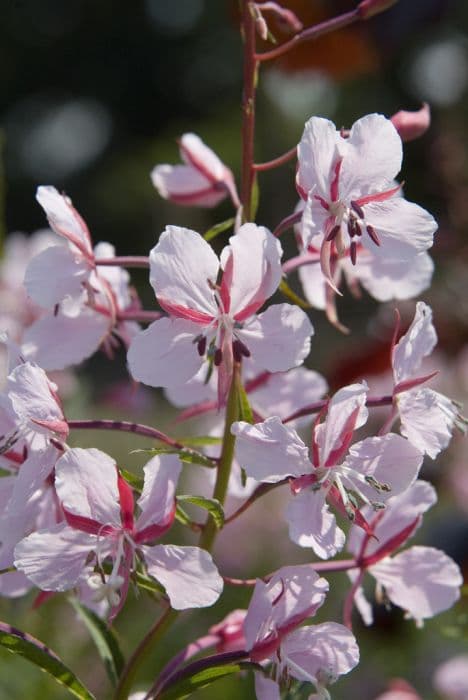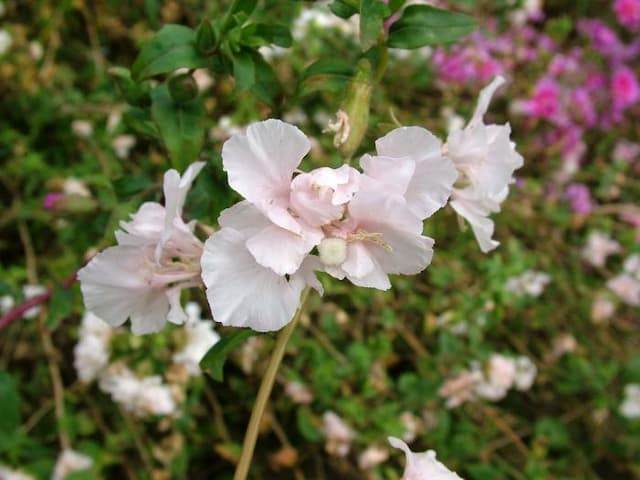Gaura Oenothera lindheimeri Belleza Series (G)

ABOUT
Commonly known as the Gaura, the Oenothera lindheimeri Belleza Series adorns gardens with its graceful and airy appearance. This attractive perennial is known for its beautiful, star-shaped flowers which bloom along thin, wand-like stems. The flowers themselves are a sight to behold, typically showcasing shades ranging from white to soft pink, often with a hint of blush that enhances their appeal. These charming blooms may have a delicate look, but they cluster densely along the stems, creating a lovely frothy effect. The foliage of the Gaura is also noteworthy, with lance-shaped leaves that form a bushy mound at the base of the plant. The leaves may be green or sometimes tinged with maroon, especially as cooler temperatures arrive, adding another layer of interest to this ornamental variety. The plant has a bushy, mounded form, and carries its flowers high above the foliage, which gives it a light and airy feel that seems almost to dance in the breeze. With a long blooming season, the Gaura remains a focal point in gardens through many months, providing a long-lasting display of movement and color. Its overall shape and the way it carries its blooms give it a whimsical charm that can soften garden borders and act as a backdrop for shorter plants in the garden design. Despite the exclusion of size-related terms in the description, it's worth noting that the Gaura's structural features—such as the length and arching nature of its stems, the dainty size of its flowers, and the form of its foliage—contribute to its overall elegant appearance, making it a beloved choice among garden enthusiasts for adding refined beauty to their outdoor spaces.
About this plant
 Names
NamesFamily
Onagraceae
Synonyms
White Gaura, Lindheimer's Beeblossom, Gaura, Whirling Butterflies, Wand Flower
Common names
Gaura lindheimeri, Gaura lindheimeri var. lindheimeri, Gaura lindheimeri ssp. lindheimeri
 Toxicity
ToxicityTo humans
Gaura is generally regarded as non-toxic to humans. There have been no widespread reports of toxic reactions in humans due to ingestion or contact with the plant. Thus, consuming or touching Gaura is not likely to cause poisoning or adverse health consequences.
To pets
Gaura is not known to be toxic to pets. It is generally considered safe for dogs, cats, and other animals. Ingesting parts of the Gaura plant should not cause poisoning or toxic symptoms in pets. However, it is always a good practice to prevent pets from eating plants as individual animals might have unique sensitivities.
 Characteristics
CharacteristicsLife cycle
Perennials
Foliage type
Deciduous
Color of leaves
Green
Flower color
Varies
Height
1-2 feet (30-60 cm)
Spread
1-2 feet (30-60 cm)
Plant type
Herb
Hardiness zones
5-9
Native area
North America
Benefits
 General Benefits
General Benefits- Attracts Pollinators: The Oenothera lindheimeri Belleza Series, commonly known as the Gaura, is well-loved by butterflies and bees, providing a source of nectar.
- Drought Tolerance: Gaura plants are remarkably hardy in dry conditions, making them suitable for water-wise gardens.
- Low Maintenance: They require minimal care and are relatively disease and pest-resistant, simplifying garden upkeep.
- Long Blooming Season: Gauras have a lengthy flowering period from spring to fall, offering extended visual interest in the garden.
- Visual Appeal: With its airy and elegant flowers on long slender stems, it adds an ethereal quality to the landscape.
- Adaptable: The plant is adaptable to various soil types, although it prefers well-drained soil, making it versatile for different garden settings.
- Wildlife Habitat: It creates a micro-habitat for small wildlife within the garden ecosystem.
- Easy to Propagate: Gaura can be easily propagated from seeds or cuttings, allowing gardeners to multiply their plants without additional cost.
 Medical Properties
Medical PropertiesThis plant is not used for medical purposes.
 Air-purifying Qualities
Air-purifying QualitiesThis plant is not specifically known for air purifying qualities.
 Other Uses
Other Uses- Oenothera lindheimeri, commonly known as Gaura, can be used in floral arrangements due to its delicate and airy blooms, adding a touch of elegance and height to bouquets.
- The slender stems and gentle movement of Gaura flowers can serve as a visual teaching tool in photography and art classes for capturing motion and delicacy in natural subjects.
- Gaura can be used as a natural dye source; the flowers may produce subtle hues that can be used in crafting and textile work.
- In garden design, the Gaura plant's resistance to deer makes it an excellent choice for gardens in areas with high deer populations.
- Gaura's flowers attract butterflies and bees, making it an ideal plant for those looking to support pollinator populations and create educational pollinator gardens.
- Gaura can serve as a living mulch when planted densely, helping to suppress weeds and retain soil moisture in garden beds.
- The plant's long blooming period makes it a useful study specimen for botany students examining floriculture and bloom cycles.
- Gaura's ability to thrive in drought conditions makes it suitable for xeriscaping projects, which aim to create landscapes that require minimal irrigation.
- Landscape architects can utilize Gaura in green roof projects due to its low maintenance needs and resilience to challenging growing conditions.
- Gaura is beneficial for erosion control on slopes and banks, as its root system helps to stabilize soil.
Interesting Facts
 Feng Shui
Feng ShuiGaura is not used in Feng Shui practice.
 Zodiac Sign Compitability
Zodiac Sign CompitabilityGaura is not used in astrology practice.
 Plant Symbolism
Plant Symbolism- Peace: Oenothera lindheimeri, commonly known as Gaura, often represents peace due to its delicate and ethereal blossoms that sway gently in the breeze, evoking a sense of calm and tranquility.
- Innocence: The white and pink flowers of the Gaura resemble butterflies fluttering, symbolizing purity and innocence, as butterflies are often associated with these qualities.
- Resilience: As a plant that can thrive in tough conditions with minimal care, Gaura is symbolic of resilience and can remind one of the strength to withstand difficult situations.
 Water
WaterGaura, commonly known as the Oenothera lindheimeri Belleza Series, requires moderate watering, usually about once a week, but frequency should be adjusted depending on weather conditions. During the hotter months or in especially dry climates, it might need watering two to three times per week. Provide enough water to moisten the soil to a depth of about 8 to 10 inches, which typically equates to about 1 gallon per plant. Over the cooler months, reduce watering to prevent soggy soil, as Gaura is drought-tolerant once established. Always check the soil moisture before watering; it should be slightly dry an inch below the surface.
 Light
LightGaura thrives in full sun conditions, preferring at least 6 to 8 hours of direct sunlight each day. It's best planted in a spot that receives unhindered sunshine throughout the day to ensure optimal growth and blooming. If located in a garden bed, place it where it won't be shaded by taller plants. Avoiding too much shade is key for these plants as it could impact their blooming and overall vigor.
 Temperature
TemperatureGaura is hardy and can tolerate a wide range of temperatures, from as low as 20°F to high temperatures above 90°F. However, it thrives best in temperatures that range between 60°F and 75°F. Though it can handle the cold, it's important to protect it from prolonged freezes as extreme cold can damage the plant.
 Pruning
PruningPruning Gaura helps to maintain its shape and encourage bushier growth. Light pruning can be done throughout the growing season to remove spent flowers and any leggy stems. A more substantial cutback should be done in the early spring to promote fresh growth, staying mindful to leave several inches of stem above ground level.
 Cleaning
CleaningAs needed
 Soil
SoilThe best soil mix for Gaura, commonly known as Wand Flower, should be well-draining and rich in organic matter. A mix of two parts garden soil, one part peat or coconut coir, and one part perlite or sand is ideal. Maintain a soil pH between 5.5 and 7 to ensure optimal growth.
 Repotting
RepottingWand Flower, typically doesn't require frequent repotting as it prefers to be root-bound. It should be repotted every two to three years or when it outgrows its current pot.
 Humidity & Misting
Humidity & MistingWand Flower thrives in average humidity levels typically found in outdoor environments and does not require any special humidity adjustments when grown outdoors.
 Suitable locations
Suitable locationsIndoor
Plant Gaura in a bright spot with direct light.
Outdoor
Plant Gaura in full sun with well-drained soil.
Hardiness zone
5-9 USDA
 Life cycle
Life cycleOenothera lindheimeri Belleza Series, commonly known as Gaura, begins its life cycle as a seed which, under favorable conditions of warmth and moisture, germinates and sprouts. The seedling emerges, developing roots and a shoot with leaves that photosynthesize to fuel growth. As the plant matures, it forms a bushy clump of lance-shaped foliage, with stems that may reach up to 2 feet tall. During the blooming stage, which typically occurs from late spring to autumn, the plant produces delicate flowers on long, airy spikes that can be white, pink, or bi-colored. After pollination, often by bees and butterflies, the flowers develop into small, dry fruit (capsules) which contain seeds, completing the reproductive cycle. With the arrival of winter, Gaura may die back, especially in cooler climates, but it can resprout from its perennial rootstock when the next growing season begins.
 Propogation
PropogationPropogation time
Spring to Summer
The most popular method of propagation for Oenothera lindheimeri, commonly known as Gaura, is by stem cuttings. To propagate Gaura from cuttings, select a healthy stem that is about 4 to 6 inches (10 to 15 cm) long and has multiple nodes. Cut the stem just below a node using a clean, sharp pair of scissors or pruning shears. Remove the lower leaves to expose a few nodes, as these will form the roots. Dip the cut end into rooting hormone to encourage root growth, although this is not strictly necessary. Plant the cutting in a well-draining soil mix, ensuring at least one or two nodes are buried beneath the soil. Water the cutting and place it in a bright area with indirect sunlight while maintaining consistent moisture in the soil. Roots usually develop within a few weeks, after which the new Gaura plant can be transplanted to a larger pot or directly into the garden.









